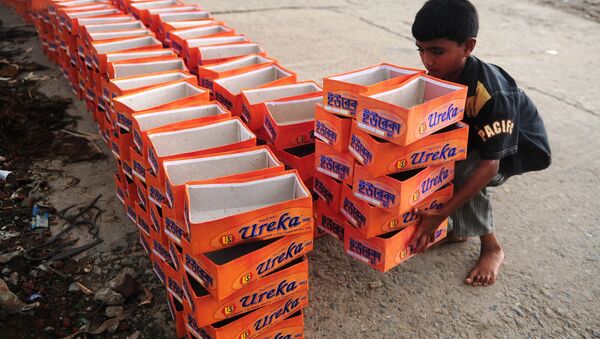The latest report, 'Child labor and education — a survey of slum settlements in Dhaka', from the Overseas Development Institute found that child laborers in the slums of Dhaka are working on average 64 hours a week — many of them employed by the garments sector.
New from ODI: insights from one of largest surveys on child work & #education in #Bangladesh: https://t.co/CD6q7SUwOp #StopChildLabour pic.twitter.com/zaT0Sik3NF
— ODI (@ODIdev) 7 December 2016
In one of the largest surveys on child work and education conducted in Bangladesh, researchers found that 15 percent 6-14-year-old children in Dhaka's slums were out of school and engaged in full time work. Average working hours were well beyond the 42-hour limit set by national legislation.
"The majority of these girls and boys are working for the garments sector, working for subcontractors producing parts for the final product which are then sold for export. Because it's informal, it's not regulated. It's much more difficult for the government to conduct inspections," Maria Quattri, co-author of Overseas Development Institute report told Sputnik.
No Future for Children
Despite the fact that education is available, families are forced into facing the economic necessity to let the children work in the sweatshops.
"It's really a matter of work. Around 70 percent of the girls say they are working to help their own household and around 50 percent of boys. These children are providing the household with an income to help the household to survive," Quattri said.
In Dhaka slums child labour is rife. What does that mean for children's #education & opportunities? https://t.co/CD6q7SUwOp #StopChildLabour
— ODI (@ODIdev) December 7, 2016
"We spoke to parents who said that without education, their children will not have any future. So they are very aware that children will not have the skills to avoid having the same kind of job in the future," she said.
"It is impossible for companies to make sure human rights are respected and that child labor is not present within their supply chains without knowing where their products are made, who is making them and under what conditions," Carry Somers, Founder and Global Operations Director, Fashion Revolution, told Sputnik.
Bangladesh child labourers working 64 hours a week — @samjahanAFP reports on new @ODIdev research #StopChildLabour https://t.co/GvNeTGFCeG
— James Rush (@jamesrush85) 7 December 2016
Lack of Transparency
The ODI report states: "We do not state outright that named foreign brands can be linked to factories employing child labor. However, it stretches credibility to assume that the supply chains for these brands do not include significant employment of child laborers.
"First, with over 60 percent of working girls and 13 percent of working boys reporting employment in the garment industry, this is the single largest source of employment for children in our sample.
"Second, the operations of direct and indirect exporters, and formal and informal suppliers, are deeply integrated. Widespread subcontracting renders it highly probable that children are producing clothing destined for international supply chains," the ODI report says.
Publishing supplier lists helps consumers shop responsibly & improves conditions for garment workers @TakePart https://t.co/b2fBFAPj8S pic.twitter.com/m9G7oCrGqL
— FashionRevolution (@Fash_Rev) 5 December 2016
"As Fashion Revolution's Transparency Index shows, the biggest names in fashion still have a lot of work to do to show their commitment to a transparent supply chain. We found that only five of the forty largest fashion companies surveyed published a list of their first tier factories and only two published second tier suppliers which includes subcontractors. Twenty-five percent of brands showed little or no evidence of monitoring labor issues in their supply chains," Fashion Revolution's Somers told Sputnik.
"Style is a way to say WHO YOU ARE without having to speak" our Ambassador @parveendusanj asks #whomademyclothes #thetruecost #blackfriday pic.twitter.com/4h4QN8wtEY
— FashionRevolution IN (@Fash_RevIndia) 25 November 2016
"We can't tackle exploitation in the fashion supply chain unless we can see it. If companies don't know how and where their clothes are made, then there is no way for them to ensure that human rights are protected," she said.


